A Look Inside the Vaccines and the Blood of the Vaccinated
More than 12.7 billion doses of the COVID-19 vaccine have been administered since the treatment became available nearly two years ago. Some have received one or two doses, while others have had multiple doses. Yet many don’t know what these shots actually contain.
The Food and Drug Administration (FDA) website provides ingredient lists for curious consumers to consider. For example, vials from Moderna and BioNTech/Pfizer famously contain messenger ribonucleic acid (mRNA). This is a genetic sequence designed to program your cells to manufacture a spike protein, thereby training the immune system to guard against the signature spike of the COVID-19 virus in the wild.
Less well-known ingredients include a different mix of lipids (fats). Pfizer’s shot, for example, contains 4-hydroxybutyl, and Moderna’s contains SM-102. These shots also include polyethylene glycol, cholesterol, a few salts (such as potassium chloride and sodium chloride), and sucrose (sugar).
Johnson and Johnson’s (Janssen’s) vaccine doesn’t contain mRNA but instead features as its main mechanism of immune system training a recombinant, replication-incompetent adenovirus expressing the SARS-CoV-2 spike protein. Like its mRNA counterparts mentioned above, the J&J vaccine contains a variety of other chemicals, such as citric acid monohydrate, trisodium citrate dihydrate, ethanol, 2 hydroxypropyl-beta-cyclodextrin, polysorbate-80, and sodium chloride.
Several items on the list of these publicly disclosed ingredients, such as mRNA and SM-102, come with controversy. Public health officials, regulators, and drug makers have been quick to defend these ingredients as safe and necessary to ensure the vaccines’ effectiveness.
Experts have also been quick to quash fears that the vaccines may contain other, even more questionable components not disclosed to the public.
The Centers for Disease Control and Prevention addresses common vaccine-related concerns such as these on its website, stating that the “vaccines do NOT contain ingredients like preservatives, tissues (such as aborted fetal cells), antibiotics, food proteins, medicines, latex, or metals.”
In regard to metals, however, some research suggests otherwise.
Presence of Metals
Earlier this year, the German Working Group for COVID Vaccine Analysis (GWG) released a report detailing what they found when examining various vaccine vials. GWG is an international network of more than 60 scientists, medical doctors, and other experts. Their goal is an in-depth laboratory analysis of these vaccines.
A microbiologist and gain of function expert from GWG, Sabine Stebel, presented the group’s findings before the World Council for Health General Assembly on Sept. 5. Researchers looked at most of the COVID-19 vaccines on the market: Johnson and Johnson, Moderna, and AstraZeneca, as well as the only shot that has received full FDA approval—Pfizer’s Comirnaty (other vaccine options have merely received emergency use authorization.)
GWG examined vials using scanning electron microscopy and energy-dispersive X-ray spectroscopy. What they found were relatively large metallic foreign bodies. The European Union’s good manufacturing practice (GMP) standards permit particle sizes no greater than a quarter of a micrometer, but GWG’s analysis discovered many metal particles from several batches that measured in the double digits. These metallic objects were found in all Pfizer and AstraZeneca vials studied, as well as some Johnson and Johnson vials, GWG said.
“If you filter a substance that is to be injected properly, you shouldn’t see anything under the microscope,” Stebel said in her presentation. “These structures are definitely too big to be injected into a living person.”
The types of particles found consisted of alkali metals such as cesium and potassium, alkaline earth metals such as calcium and barium, and cobalt, iron, chromium, and titanium. Researchers also found rare earth metals such as cerium and gadolinium, as well as aluminum, silicon, and sulfur.
Although some of these elements are nontoxic and even essential to human health, many can be highly toxic even at low doses.
One example is barium, which is toxic to humans and animals in soluble form. In high concentrations, barium blocks the passive potassium channels in the cell membrane. This leads to disturbed muscle cell function and potassium deficiency in the blood, as potassium remains in cells in increased amounts.
Another example of toxic potential found in the vaccines is the heavy metal cobalt. Although minute amounts of cobalt are essential to life, in the event of an overdose, it can lead to symptoms such as nausea, visual disturbances, heart problems, and damage to the thyroid gland.
Gadolinium is a rare earth metal used as a contrast agent in magnetic resonance imaging, but the metal can be highly toxic and can accumulate in the brain and bones.
Only Moderna vials revealed a significant concentration of antimony, which was found in the greatest concentration compared to other metal elements.
Changes in Blood
In addition to analyzing vaccine vials, GWG researchers analyzed the blood of vaccinated individuals and compared it to blood samples from nonvaccinated individuals. They found that the blood from all the vaccinated patients they tested (specifically those having had either the BioNTech/Pfizer or the Moderna vaccines) presented “novel structures,” such as rectangular crystals and spirals.
“These kinds of structures have never been found in human blood before. These structures were most frequently found in the Comirnaty vaccine from BioNTech/Pfizer,” the report reads.
Injected people have 100 percent consistently altered blood as seen with live cell dark field microscopy. This includes impeded blood flow with red blood cells sticking to each other, even to the extreme of “rouleaux formation,” and profoundly decreased red blood cell stability and survival.
Another feature of vaccinated blood samples was the degradation of the blood itself. The report provides images from live blood cell analysis of the cell membranes of erythrocytes (red blood cells that look like concave discs) that have become deformed and notes an “unusually rapid disintegration of the different types of cells in the vaccinated blood.” Such cell deformations are usually only seen in chronically ill people and people with severe degenerative diseases.
Researchers also observed frequent examples of blood clots and changes in blood viscosity, with vaccinated individuals demonstrating reduced blood flow capacity because of blood cells sticking to one another.
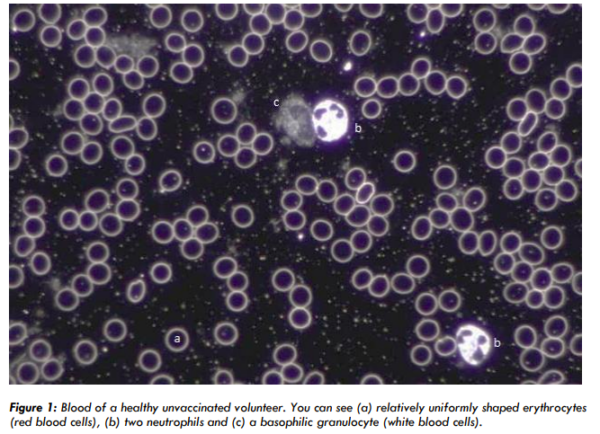
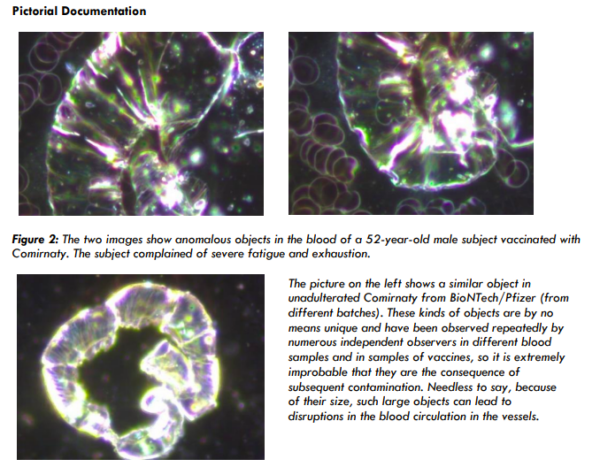
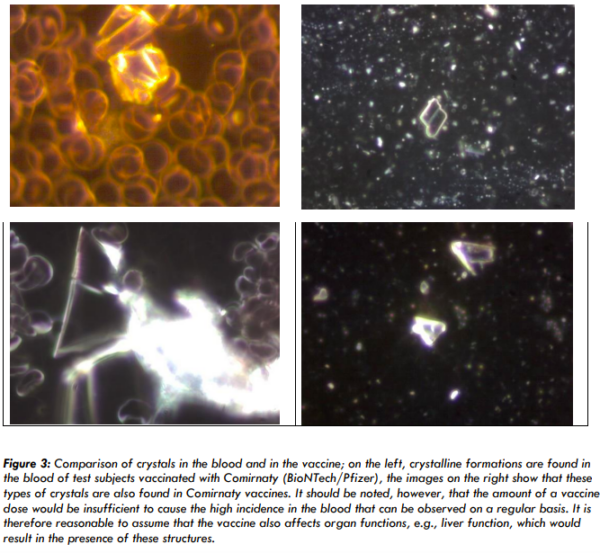

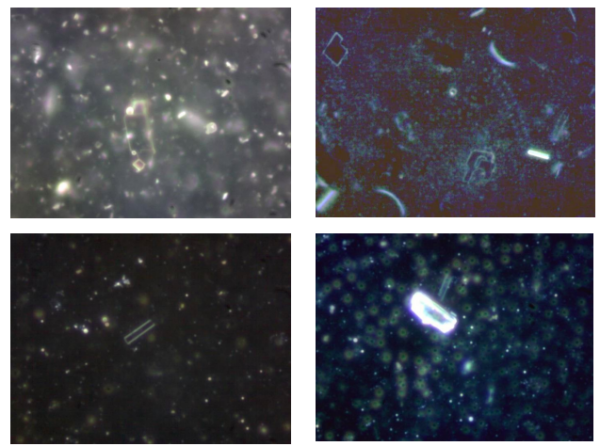
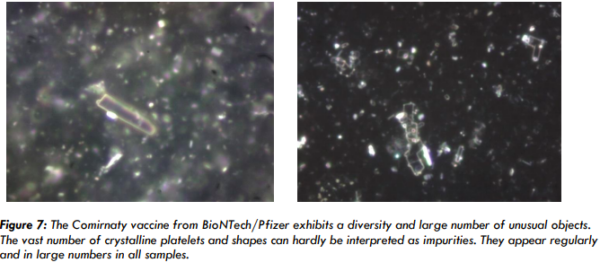



Contamination or Proprietary Secret?
Do these mystery metals serve some kind of function in the vaccine formulas, or are they merely the result of unintentional contamination?
Drug makers admit contamination is possible, as the GWG wasn’t the first to detect metal in the vials. The group’s work was initially inspired by news of stainless steel contaminants found in Moderna vaccine vials in Japan in 2021.
The deaths of two men aged between 30 and 40 occurred within days of receiving their second Moderna dose from the contaminated batches. However, Japan’s Health Ministry stated that it didn’t believe the stainless steel particles posed any additional health risk. And Moderna didn’t indicate that the presence of the particles was a part of their vaccine recipe. They stated that the contamination probably occurred during production.
Later that year, foreign material was found in unused Pfizer vials at vaccination sites in three Japanese cities. The vials (95 in total) all belonged to the same lot, but the cities that had the vials couldn’t identify the contents. They requested that Pfizer analyze the white floating matter.
At a press conference, Pfizer’s Japanese subsidiary surmised that the material was likely vaccine ingredients that hadn’t been fully dissolved and that they posed no safety or efficacy issues. The company said in a statement that it was aware of the report and was “conducting a full investigation.”
What else can be found in these vaccines? That depends on the analysis. Consider the conclusions from a Spanish-based study that found the presence of something called graphene oxide, a type of nanomaterial used in various biomedical applications.
Pablo Campra, a chemical sciences professor and researcher at Universidad de Almería in Spain, found evidence of graphene-like nanoparticles in numerous vials from four different vaccine makers. The graphene was detected using a spectroscopy technique called micro-Raman, which employs laser photons to vibrate molecules. Campra’s report from November 2021 details his technique and the results of his findings.
Campra employed the micro-Raman technique after screening various objects selected for their graphene-like appearance under optical microscopy and found conclusive evidence of graphene oxide structures
Analyses other than Campra’s have detected graphene nano-structures in the COVID vaccines. Yet the drug industry and public health experts explicitly state that these vaccines contain no such thing.
However, there’s evidence to suggest that vaccine makers may one day add graphene to their formula. A May 2021 study published in the Proceedings of the National Academy of Sciences determined that graphene oxide nanoparticles could be effective in a flu vaccine because of the material’s “high antigen-loading capacities and superior immunoenhancing properties.” Researchers say this material “can be easily adapted for constructing mucosal vaccines of different respiratory pathogens.”
Another study from May 2021 suggests that graphene oxide “nanosheets” may make valuable additions to personal protective equipment and other medical applications.
Researchers concluded that the only concern for adding graphene oxide was its potential for toxicity.
It would hardly be the first time a toxic substance was added to medicine. Many drugs employ toxic substances in low doses to provide a medicinal effect. Antimony, for example—the metal GWG found in Moderna vials—is used as an antiprotozoal adjuvant in some traditional vaccines.
The question is, are the metals and nanomaterials independent researchers are finding in vaccine vials part of a proprietary secret or unintentional contamination?
If it’s a proprietary secret, the application is inconsistent. GWG’s report states that their research team found no graphene in the vaccine samples they analyzed.
However, the materials GWG found don’t seem to be an accident either. The report notes that the Pfizer doses in particular exhibit a vast number of crystalline platelets and shapes that can “hardly be interpreted as impurities.”
“They appear regularly and in large numbers in all samples,” it reads.
Their report stresses that this summary isn’t the final word, but is instead “a preliminary, continuously evolving presentation of research.” Scientists call for further investigation and discussion.
“Much still remains to be analyzed, but what we have found—we are convinced—is so important that the public in general and the scientific community in particular must be informed about it. There needs to be a wider understanding of the dangers that the COVID-19 vaccines pose to health and research into how the worst effects of these vaccines can be prevented, or at least mitigated,” researchers wrote.



